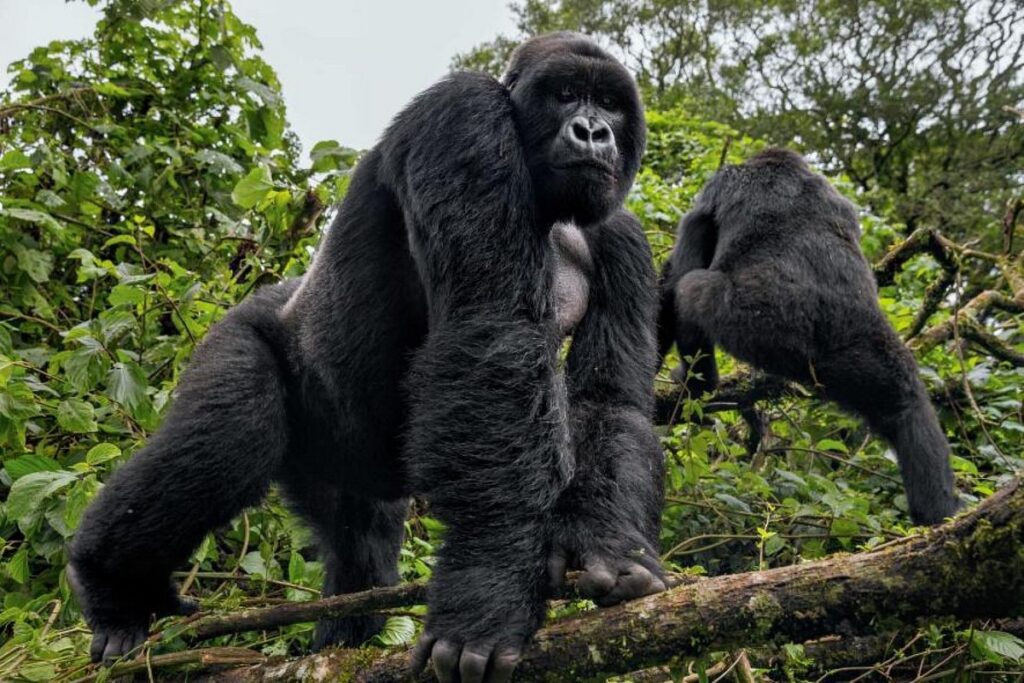Do Mountain Gorillas Climb Trees
Do mountain gorillas climb trees? The inquiry regarding the arboreal behavior of mountain gorillas has consistently been a topic of debate among visitors; nonetheless, this article will provide a definitive response to your issue. These Giant Apes belong to the Eastern gorilla species, which includes the Eastern lowland gorillas, and primarily inhabit the densely forested mountain slopes at elevations between 8,000 and 13,123 feet above sea level. These locations are characterized by low temperatures, and one adaptation of these gorillas to endure such challenging conditions is their darker, denser, and longer fur.

In terms of body size and weight, these Great Apes range from four to six feet in height and weigh between 130 and 220 kilos, rendering them the second-largest gorilla sub-species after the Eastern lowland gorillas. Considering their substantial size and mass, one could question their ability to ascend trees. These remarkable monkeys predominantly inhabit the ground, dedicating the majority of their day to terrestrial activities, with only five to twenty percent of their time spent in trees, so addressing the inquiry of their arboreal climbing behavior. Indeed, mountain gorillas ascend trees, however chimpanzees allocate a greater proportion of their time to arboreal activities (forty-seven to sixty-one percent of the day), whereas orangutans predominantly inhabit trees throughout the day.
Mountain gorillas predominantly remain on the ground, ascending trees primarily for play, particularly among infants, and for foraging fruits. Typically, when they ascend trees, they utilize all four limbs and seldom employ their arms to swing across branches, unlike chimpanzees and other tiny monkey species. Notably, juvenile mountain gorillas engage in arboreal activities more frequently than adults, primarily for play, a behavior facilitated by their diminutive size and weight. Mountain gorillas seldom ascend trees due to the scarcity of suitable trees for nest construction and the limited availability of fruit-bearing trees in their natural environments. Typically, they grasp tree branches and slender trunks with both their hands and feet while ascending trees.
The western lowland gorillas, inhabiting the tropical rainforests of Central Africa—specifically in Gabon, the Central African Republic, Cameroon, Angola, the Republic of Congo, and Equatorial Guinea—expend considerable time in trees, especially the adults. Adult male mountain gorillas, known as silverbacks, seldom traverse the ground or ascend trees due to their considerable mass, however they may climb to fruiting trees provided the branches can support their weight. Consequently, several silverbacks have perished while attempting to procure fruit, exemplified by silverback Ndahura, the former leader of the Bitukura gorilla troop, who died at the age of 28 in December 2016 after falling from a tree. In 2013, Ruhamuka, a 30-year-old subordinate silverback of Kahungye, incurred severe brain injuries from a fall and subsequently died.
What is the best period for observing mountain gorillas?
Mountain gorillas inhabit three countries: the Democratic Republic of Congo, Rwanda, and Uganda, and can be observed year-round, as each season provides distinct experiences. The dry season provides drier hiking routes due to minimal or no precipitation, resulting in less demanding hikes. Nevertheless, diminished or complete lack of precipitation during the arid months—January, February, June, July, August, September, and December—results in desiccation of vegetation, consequently leading to a decrease in food availability; hence, explorers will need to traverse greater distances to locate the mountain gorillas.
The rainy season brings substantial rainfall that can postpone hikes and render hiking trails wetter, muddier, and more treacherous. However, the vegetation is more verdant, and the sky is devoid of dust, so enhancing visibility and photography.
